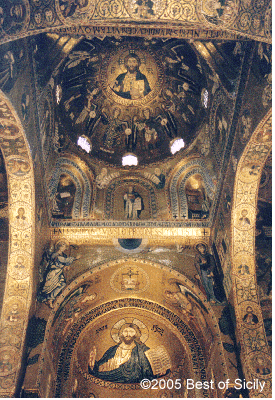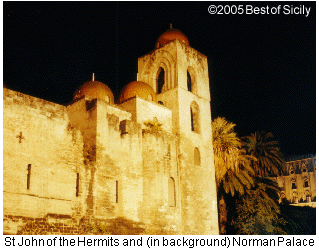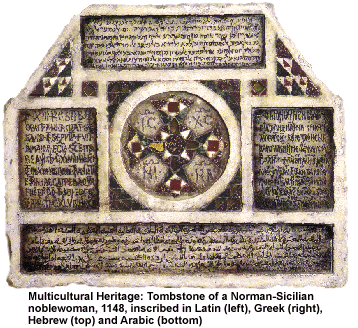...Best of Sicily presents... Best of Sicily Magazine. ... Dedicated to Sicilian art, culture, history, people, places and all things Sicilian. |
by Carlo Trabia | |||
Magazine Index Best of Sicily Arts & Culture Fashion Food & Wine History & Society About Us Travel Faqs Contact Map of Sicily
|
Norman-Arab was a unique style, part of a multicultural experiment that lasted several centuries. By 1200, it was supplanted by Swabian and other quasi-gothic styles (the true Gothic never made decisive inroads into Sicily except for churches like Saint Mary of the Germans in Messina), but at its apex, from about 1080 to around 1200, Norman-Arab architecture was the order of the day, and its Byzantine touches distinguished it from slightly similar styles in Moorish-Visigothic Spain. Its development was a historical coincidence, but hardly an accident. It began in the late 1070s, with large parts of Sicily (including Palermo) under Norman control. Following the decisive battle of Palermo in the early days of 1072, the conquerors decided to keep the best of Byzantine and Arab culture, government and law in tact, adding their own northwestern European institutions to the mix whenever this was deemed necessary or pragmatic. Seen in this context, the Norman-Arab architectural style was a logical reflection of Sicilian society itself. It is said that the Normans who conquered England found simple wooden churches and in their stead built majestic stone cathedrals. A simplification, certainly, but Sicily's eleventh-century infrastructure was --by any standard-- far more advanced than that of Saxon England. The architecture of the Byzantine Greeks and Saracen Arabs was sophisticated, sturdy and aesthetic. It left little to be desired. The Norman architects merely embellished it, adding arches and columns, and combining elements which, until the twelfth century, were rarely found together beyond Constantinople, Alexandria or Baghdad. Unlike these cities, Norman Palermo (the Arabs' Bal'harm) was legitimately multi-cultural. The king was Christian but there was, as yet, no "official" religion. Muslims, Christians and Jews enjoyed equality of freedom of worship, laws were published in several languages, and the streets were full of Greek-speaking Byzantines, Arab-speaking Saracens (Moors) and the occasional Norman or Lombard. All were part of a nation which was just beginning to emerge with its own ethnic identity --that of Sicily and its Sicilians. It's difficult to define the unique style. Despite identifiable trends, each structure is unlike any other. The cupolas of Saint John of the Hermits (shown here) and other small churches make the buildings look like mosques. The apses of the Magione, Palermo Cathedral and Monreale Abbey have intricate Arab geometry reflecting Muslim spirituality. Cefalù Cathedral, with its high walls, Latin Cross layout and long nave, takes the first tentative steps toward the rare Sicilian Gothic. The mosaic icons of the Martorana, Cefalù Cathedral, the The Cuba, the Zisa, the Cubola ("Little Cuba") and the Scibene (now in ruins) were constructed as royal residences or refuges in the middle of a vast royal park and hunting ground which extended as a long rectangle from the royal palace and city walls (near the present Porta Nuova) southward to the foot of Monreale's hill, and over to Altofonte (formerly "Parco" where Saint Michael's Chapel still stands), bordered by what are now Via Pitré and Via Dante and, on the opposite side, Via E. Basile (between the university and the hospital). While this area still has a few patches of woods, citrus orchards and other greenery (the restored Zisa is now surrounded by an Arab-style park), it is largely "developed" and densely populated. In the days of the Norman kings and their descendant, Frederick II, the Genoard park had gardens, fountains, woods and a zoo. By Frederick's time, the Norman-Arab style was being supplanted by the so-called Swabian style, a European Romanesque order influenced by the early Gothic, characterised by details such as arched two-light windows. True, some of these features were present in Sicily during the waning decades of the Norman era, but it was during Frederick's thirteenth-century reign that they became widely popular. Let's cast an eye over a few particular architectural elements of Sicil's Norman-Arab-Byzantine school. The carved and painted wooden coffers (muqarnas) of the ceiling in Palermo's Zisa palace and Palatine Chapel are an Arab element. So are the cupolas of San Cataldo and both Palermitan churches of Saint John (and several similar churches elsewhere in western Sicily), though these may not originally have been painted pinkish red. The geometric interlaced arches and other designs of the exteriors of the apses of Palermo Cathedral, Monreale Abbey and the Magione Basilica are typically Arab --and Muslim-- motifs. The ornate crenels along the roofline of San Cataldo are a Moorish element, and so are the laced geometric screens covering the windows (most are actually faithful reconstructions). The battlement crenels (similar to those of castles) of Cefalù Cathedral and Monreale Abbey are The origin of arch design is a subject which sparks debate. Contrary to popular belief which attributes them exclusively to Germanic and Frankish (and Early Gothic) influences, pointed arches were known in the architecture of mosques and Eastern (Byzantine) churches as well as northern European (Latin) Romanesque structures, though in Sicily these seem to have been popularised by the Normans. (As few purely Arab structures built before 1070 have survived in Sicily, we rely on Tunisian architecture for comparisons.) The front of Cefalù Cathedral seems to based largely on the design of Saint Etienne church, with other details modelled on those of Caen's country churches. The mosaic work, either on church walls or in some columns of Monreale cloister, is Byzantine. Two themes are dominant: Biblical scenes and icons. The floor designs of Monreale Abbey and the Palatine Chapel, in stone inlay, are an essentially Arab feature which (technically but not aesthetically) Islamic architects may have initially borrowed from Byzantium's churches for use in their earliest mosques. The "blind" windows and arches on the external walls of the Magione, the Cuba and the Zisa are usually identified with Arab Islamic art. By the Swabian (Hohenstaufen) era, Orthodox (Byzantine) Sicily was already becoming gradually Latinized under the Church of Rome, and Muslims were converting en masse to Christianity (as Roman Catholics). The Norman-Arab-Byzantine style, and the remarkable polyglot society that spawned it, could not last forever, but it's pleasant to remember what it was, and in the Sicilian capital of the Normans and Arabs it still makes a lasting impression. About the Author: Architect Carlo Trabia has written for various magazines and professional journals, as well as this online magazine. | ||
Top of Page |
 It was a singular movement which, in its ultimate expression, encompassed
three diverse styles under the architectural umbrella of the Romanesque:
Norman, Arab, Byzantine. And its epitome took form in and around Palermo,
where it can still be seen. It's not a question of a single monument but
several. The churches include the
It was a singular movement which, in its ultimate expression, encompassed
three diverse styles under the architectural umbrella of the Romanesque:
Norman, Arab, Byzantine. And its epitome took form in and around Palermo,
where it can still be seen. It's not a question of a single monument but
several. The churches include the  Palatine Chapel and, of course, breathtaking Monreale, give these churches an Eastern Orthodox flavour --though, strictly speaking, they stand among the first "Latin" or Roman Catholic churches of Sicily. The cloisters' courtyards are decidedly Latin in their general design, not unlike what one encounters in France, Germany or England. The Norman Palace (the Pisan Tower still resembles its original form), Cuba and Zisa are, in many ways, strongly Arabic.
Palatine Chapel and, of course, breathtaking Monreale, give these churches an Eastern Orthodox flavour --though, strictly speaking, they stand among the first "Latin" or Roman Catholic churches of Sicily. The cloisters' courtyards are decidedly Latin in their general design, not unlike what one encounters in France, Germany or England. The Norman Palace (the Pisan Tower still resembles its original form), Cuba and Zisa are, in many ways, strongly Arabic. Norman elements. So are the long naves of these churches, while their cloisters, as well as those of the Magione and Saint John of the Hermits, are essentially a Norman element.
Norman elements. So are the long naves of these churches, while their cloisters, as well as those of the Magione and Saint John of the Hermits, are essentially a Norman element.